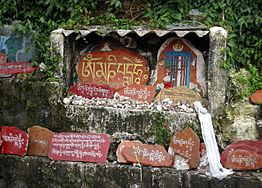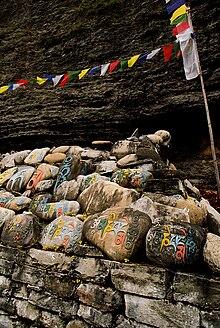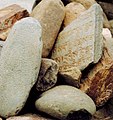Mani stone
This article needs additional citations for verification. (February 2011) |

| Part of a series on |
| Tibetan Buddhism |
|---|
 |
Mani stones are stone plates, rocks, or pebbles inscribed with the six-syllabled
.The preferred technique is
sunk relief
, where an area around each letter is carved out, leaving the letters at the original surface level, now higher than the background. The stones are often painted in symbolic colours for each syllable (om white, ma green, ni yellow, pad light blue, me red, hum dark blue), which may be renewed when they are lost by weathering.
Mani walls
Along the paths of regions under the influence of
Buddhist
doctrine.
They are sometimes close to a temple or
chorten, sometimes completely isolated and range from a few metres to a kilometre long and one to two metres high. They are built of rubble and sand and faced with mani stones engraved in the elegant Tibetan script.[4]
Nepal

The same type of mani stones can be seen in neighbouring
prayer flags
in Nepal.
Gallery
-
Mani wall in the Langtang Valley, Route to Kyanzing Valley, Nepal.
-
Mani stones &Lahaul.
-
Mani wall along driveway to Hemis Monastery
-
Mani wall in Zanskar subdistrict, Ladakh
-
Huge mani stone in theSpiti Valley, India
See also
- Gsumge Mani Stone Castle
- Śarīra
- Stele of Sulaiman, 1348 stele with Om mani padme hum inscribed in six scripts
- Yongning Temple Stele, 1413 stele with Om mani padme hum inscribed in four scripts
References
- ^ a b c Mani Stone
- ^ Mani stone at the British Museum
- ^ OCLC 36130642.
- ISBN 0-19-564546-4
External links
Wikimedia Commons has media related to Mani stones.






